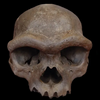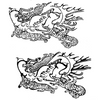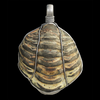Giga-Goose: a New Fossil Discovery!

Genyornis newtoni paleo art by Jacob C. Blokland
Post Author - J. Carlin Decker III
A new discovery of a giant prehistoric bird in a southern Australian lakebed suggests a very distant, and extremely large relative to our modern day honking waterfowl. This fantastic new find of a skull and a few other bones from Genyornis newtoni, or Newton’s thunder bird, has given us new insight about this large, ancient species.
A skull of G. newtoni was first discovered in 1913, and its name comes from English ornithologist Alfred Newton. Unfortunately, that specimen was deteriorated from salt buildup as well as damaged by overpopulated rabbits burrowing for nourishment. In 2014 vertebrae paleontologist at Flinders University, Jacob Blokland, went out to that initial excavation site, and in 2019, found quite a bit more about this elusive bird.

The remains of the Giga-Goose skull
The original excavators were able to determine that G. newtoni was about 230 kilograms, 2 meters tall (twice the size of an ostrich), and about 50,000 years old, surviving into the Pleistocene Epoch. Based on this initial find, researchers concluded that this bird was more related to another group of giant, flightless birds, gastornithids, that primarily roamed about North America, Europe, and Asia. However, the bombshell find of Blokland’s newfound specimens suggests that G. newtoni is likely the cousin of a completely different group of birds.
Blokland hypothesizes that G. newtoni is more closely related to screamers, a South American waterfowl, but also there are similar skull structures to that of the magpie goose. The more complete skull on the 2019 specimen shows an extra, gooselike bump on the top of its bill, and the way it is shaped suggests it was fit for aquatic life. The shape of the bones in its skull would have helped prevent the flow of water into the ears, making it significantly easier to hunt via the dipping of the head.
Researchers believe that the extinction of G. newtoni was caused by the migration of humans onto the Australian continent, about 65,000 years ago. Environmental factors, such as drier and saltier lakes in southern Australia also contributed to the bird’s demise. This new discovery helped clear up the phylogenetic confusion from 1913, but it is also just intriguing to find out more about these ancient geese.
Featured Product
Space Exposed Tomato Seeds
Cool Things!

Learn About The Newly Discovered Species of Early Humans!
In studying early human ancestors, known as “hominids,” anthropologists have historically found much wider variations from specimen to specimen than expected, particularly among other paleontological fields. A recent study argues that certain groups of hominid fossils previously thought to be an already discovered species constitute a new one entirely.

Learn About Iron Age Mummy Tattoos!
Tattoos have been a popular form of individual and societal expression for centuries around the world, making them a focal point of study for anthropologists and archaeologists. Unfortunately, the oldest examples are rarely preserved well enough for deep study, since skin usually decomposes before fossilization. In one recent case, however, new technology allowed researchers to draw new conclusions about the tattoos of one fascinating specimen: a well-preserved mummy.

Scientists Discover First Ever Ancient Roman Trilobite!
It’s well known among archaeologists that the ancient Romans had a reverence for fossils. For example, it is thought they believed mammoth bones and teeth were those of dragons and cyclopes, and thus, these items were often displayed in places of power. However, researchers in Spain recently uncovered an exceedingly rare Roman fossil artifact from an unlikely place.
Specimen Deep Dives

Old Ironsides: The USS Constitution and the Start of the U.S. Navy

The Hollywood Sign: The Story of a City's Symbol Hollywoodland

Building Disneyland
Long Form Articles

The Artist Behind the Macintosh: Susan Kare and Apple Computers
While the two Steves, Jobs and Wozniak, are the most well known faces behind Apple computers, equally important to the products and culture of the company were those who crafted the experience of using their computers through design. The most notable of these visual architects was Susan Kare, a designer responsible for “humanizing” Macintosh computers.

Can I Lick It? Yes You Can!
Have you ever been unable to tell if a fossil was really a fossil, but you were too embarrassed to admit it? Have you ever wanted to lick a fossil just because, but you didn’t want to risk judgment from your peers? Well, good news! You can kill two birds with one stone! Licking a fossil can actually help you determine if it’s the real deal or just another rock.

Is It Legal To Own a Meteorite: How to Start Your Outer Space Collection!
Meteorites are some of the rarest geological specimens to be found on Earth. Of course, since these stones are not of our world, purchasing them can sometimes be a confusing process. Is it legal to own a meteorite? In short, yes! Read on for help starting your cosmic collection!









